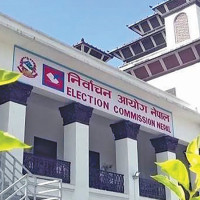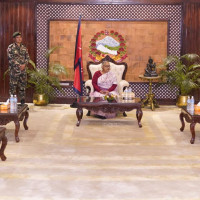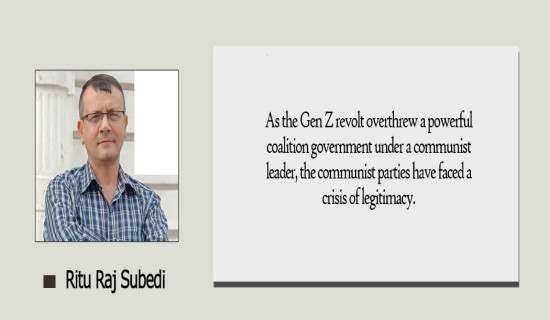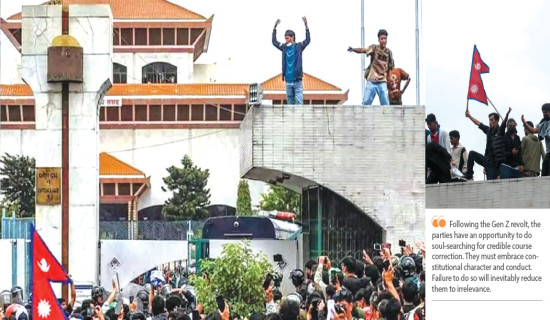- Saturday, 27 December 2025
70th Anniversary Of Nepal-China Ties
Focus On Implementation Of Past Accords
As Nepal and China are observing the 70th anniversary of the establishment of their diplomatic relations, the focus must be shifted to implementing various bilateral agreements signed between the two nations. Despite having close and cordial ties, Nepal is yet to benefit from the second-largest economy that is surpassing even the US in several areas, including manufacturing and innovation outputs. The mighty Himalayas that stand between the two nations are considered a symbol of friendship, though Western-centric observers view them as a barrier to trade and travel between the two nations. The cutting-edge technology is there to physically connect the people of the two nations.
Nepal and China established their diplomatic relations on August 1, 1955, which formalised the age-old social, economic and cultural bond. “The two governments believe that the establishment of diplomatic relations will also promote further development in the cultural and economic cooperation between the two countries,” stated a joint communique released after the signing of the historic accord. The China-Nepal Boundary Agreement was signed on March 21, 1960, during Prime Minister BP Koirala’s visit to the northern neighbour. Before the inking of the agreement, Prime Minister Koirala and Chairman Mao had a meeting on enhancing the bilateral ties. Mao said, “The Sino-Nepalese border should be peaceful and friendly forever.”
Bilateral cooperation
A Treaty of Peace and Friendship, which Prime Minister BP Koirala and Premier Chou Enlai of China signed in Kathmandu on April 28, 1960, served as the foundational basis of bilateral cooperation between the two nations. Based on Panchasheel (the Five Principles of Peaceful Co-existence), it stresses respecting each other's independence, sovereignty, territorial integrity and the principle of equality and mutual benefits. Economic Aid (1956), Trade and Transit Agreement (2016), Memorandum of Understanding on Cooperation under the Belt and Road Initiative (2017) and Framework for Belt and Road Cooperation (2024) are some vital accords aimed at boosting connectivity, investment, trade, infrastructure development, tourism and people-to-people contact, among others, between the two neighbours. Scores of bilateral agreements and exchange of visits at different levels have further consolidated Nepal-China ties.
Nepali Prime Ministers – Tanka Prasad Acharya, BP Koirala, and Kings Mahendra and Birendra, and Chairman Mao, Premier Chou Enlai and paramount leader Deng Xiaoping had laid the foundation stone of Nepal-China ties. However, the later generation of political leadership has equally played their role in nurturing the relations. Nepal has pursued a foreign policy based on the principle of 'friendship with all, enmity with none.' On the other hand, the present Chinese leadership has attached priority to the ‘neighbourhood diplomacy’ that emphasises a sound regional environment and common development. During Chinese President Xi Jinping’s visit to Nepal in 2019, Nepal-China relation was upgraded to a strategic partnership of cooperation, featuring everlasting friendship for development and prosperity.
Nepal has witnessed many socio-political ups and downs in the last seven decades. At least three big democratic movements took place in the country. In 2015, Nepal became a federal, secular democratic republic. No matter which political system Nepal adopts, this has not affected ties with China. China wants political stability, policy consistency and credible leadership in Nepal so that there will not be difficulties in implementing the development projects inked by the two countries. With the rise of Deng Xiaoping, China stopped importing ideology and supporting communist movements in other countries. It recognises and deals with the legitimate power and stresses practical and win-win cooperation. The political leadership of different hues, bureaucrats, intellectuals and the business community need to understand this nature of Chinese diplomacy.
Of late, Nepal has become a geopolitical hotspot with different powers vying to have their sphere of influence in the Himalayan nation. The Trump administration policy has given continuity to the Millennium Challenge Corporation (MCC) in Nepal, although it has dismantled the United States Agency for International Development (USAID) and other foreign aid instruments. This indicates Nepal is on the US geopolitical radar. This evolving dynamism requires espousing a balanced foreign policy that effectively allays the security concerns of neighbours. China has a valid security concern—foreign elements must not abuse Nepali territory against China. Nepal has well understood these concerns and adopted a policy accordingly. It has not allowed any anti-Chinese activities on Nepali soil, while continuously expressing its commitment to the One-China principle. It has opposed ‘Taiwan independence’ and reiterated that Xizang matters are internal affairs of China.
Structural crisis
Nepal is going to graduate from its Least Developed Country (LDC) status to a developing country in November next year. Despite this gain, Nepal is fraught with instability, inflation, poverty, unemployment, external and internal debt, exodus of active workforce, capital flight and eventual brain drain. These malaises mainly stem from a poor manufacturing base, lack of agriculture modernisation, inadequate investment in technological innovation and deterioration of the quality of education. The blind adoption of neo-liberalism in the early 1990s led to the privatisation of industries established with the financial support of China and the former Soviet Union. The defective economic policy weakened the country’s sovereignty and accelerated the deindustrialisation process. Against this backdrop, the implementation of BRI projects can be instrumental in overcoming the nation’s structural crisis.
Over the last seven decades, China has provided financial support to around three dozen infrastructure projects related to highways, roads, education, health, disaster management, and energy, most of which have been completed, while some are currently under construction. The two nations should work together to ensure the smooth operation of border points and China-funded airports and expedite oil and gas drilling for their long-term benefit. Now they need to work in partnership in the area of climate change, also. Last month, flash floods in the Bhotekoshi, Trishuli and Narayani Rivers caused huge damage to lives and infrastructure. Nepal-China Friendship Bridge in Rasuwa has also been swept away. A sudden drainage of a supraglacial ice in the Tibet Autonomous Region caused the disaster. This is a clear example that climate change-induced calamities cannot be confined to national boundaries, nor can they be handled without cross-border collaboration.
Multidimensional connectivity
The BRI is at the heart of building the Trans-Himalayan Multidimensional Connectivity Network (THMDCN), which the two nations agreed in 2018, through the construction of ports, roads, including bridges and tunnels, railways, aviation infrastructure, telecommunication projects, and electricity transmission lines, to upgrade the level of connectivity. During Prime Minister KP Sharma Oli's visit to China last year, the countries signed the Framework for Belt and Road Cooperation, paving the way for the implementation of 10 projects based on ‘aid financing modality’ and with Chinese technical support. They are related to cross-border railway and transmission lines, roads, bridges and tunnels, industrial parks, sports, and scientific research. However, major political parties are divided on the funding modality of these projects.
The aid financing modality comprises grants, loans and investments, which are generally practiced by the multilateral agencies such as the World Bank and Asian Development Bank. BRI also has the components of grants, soft loans, or loans and investments. As the Nepali Congress, the largest party in the parliament insists on building BRI projects on grants, not even on soft loans, their progress has been inordinately slow. The two sides are yet to complete the pre-feasibility studies of these projects. Hidden geopolitical factors and the myth of debt-trap diplomacy have been blamed for the sluggish pace of their execution. Nepali political parties require developing a common viewpoint on foreign aid, grants, loans and projects so that the global development initiative like BRI does not fall victim to political inertia and posturing.
(The author is Deputy Executive Editor of this daily.)





-square-thumb.jpg)











